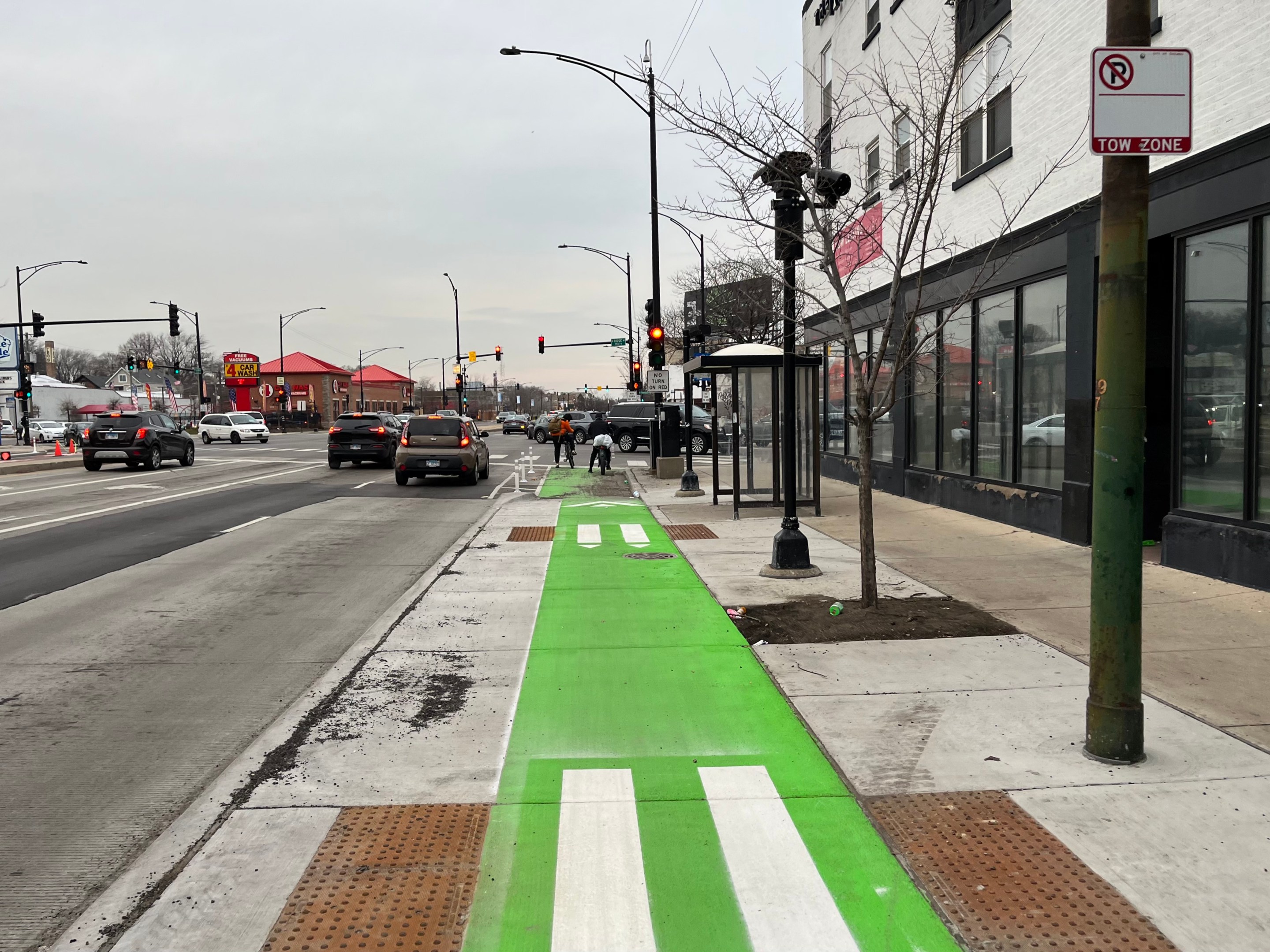By Sharon Hoyer

Yesterday, the City’s Committee on Pedestrian and Traffic Safety heard a presentation from Chicago Department of Transportation bike and pedestrian czar Dave Smith on the agency’s strategy for improving bike infrastructure and encouraging more people to ride bikes in Chicago.
The Chicago Cycling Strategy was published last March under the Mayor Lori Lightfoot administration, and much of the hearing was a celebration of improvements made under the new framework. A dozen residents and advocates went on the record during the public comment section of the meeting, most commending CDOT for numerous protected bike lane installations completed in the last year and calling on the agency to expand work in the year to come.
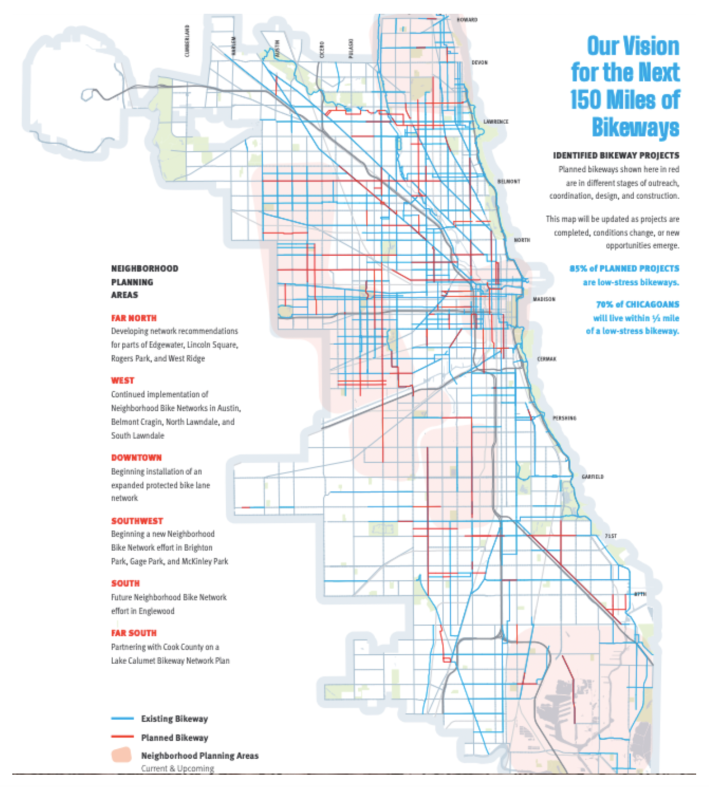
Alex Perez of the Active Transportation Alliance voiced support of the strategy and encouraged CDOT to continue pursuing capital for new projects. Dixon Galvez-Searle of Southwest Collective requested that Archer Avenue—a wide and notoriously dangerous thoroughfare not currently slated for bike lanes—be included in the plan for a citywide bike network. Andrew Mack of Chicago Family Biking asked CDOT to consider accommodations to help people biking to and from the suburbs and called for greater investment in neighborhoods like Bridgeport that are cut off from biking to surrounding neighborhoods by obstacles like the Chicago River, railroad tracks, and industrial parks.
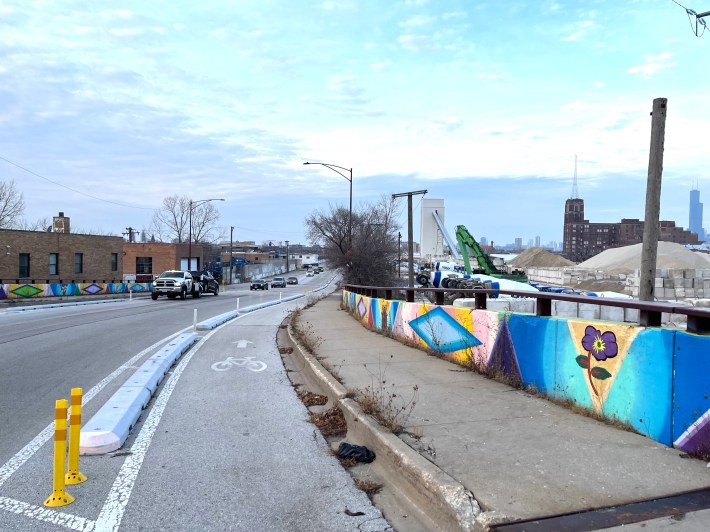
Chicagoans unaffiliated with advocacy groups also showed up to comment. A Bronzeville resident complained about drivers speeding down Martin Luther King Drive, endangering pedestrians, many of whom in her neighborhood are seniors. Another attendee asked the committee to imagine closing the boulevard system to motor vehicles, creating "safe spaces for fellowship and recreation, and connecting the South and West sides to the rest of the city."
Two attendees voiced displeasure with the new bikeways. One resident complained about some car parking spaces being converted for the installation of protected bike lanes. Lincoln Park attorney Edward "Ed" C. Fitzpatrick railed against the (allegedly but not actually "Chicago-taxpayer funded") financing of the recently completed Dickens Avenue Neighborhood Greenway. His comments were part of his longtime, until recently behind-the-scenes, campaign to block the construction of the bikeway, which helps connects the Bloomingdale Trail to the Lakefront Trail.
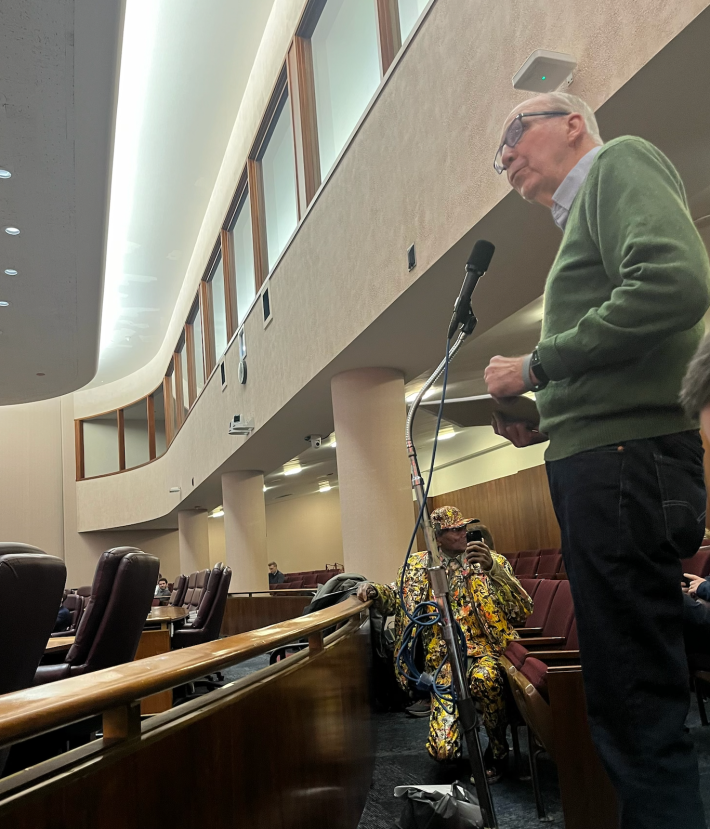
[We didn't originally plan to run photos of Fitzpatrick on Streetsblog two days in a row, but he happened to appear at this meeting on the same day that we published another article about him! - Ed (John Greenfield, not Ed Fitzpatrick)
After the public comment period, Smith presented on the Chicago Cycling Strategy, which views bikeway improvements at three scales: a citywide bike network; neighborhood-level trips to schools, parks, and local businesses; and block-by-block planning of "low-stress" bike routes. The framework is designed to consider the unique needs of each neighborhood while working toward a safe and connected network of crosstown bike routes.
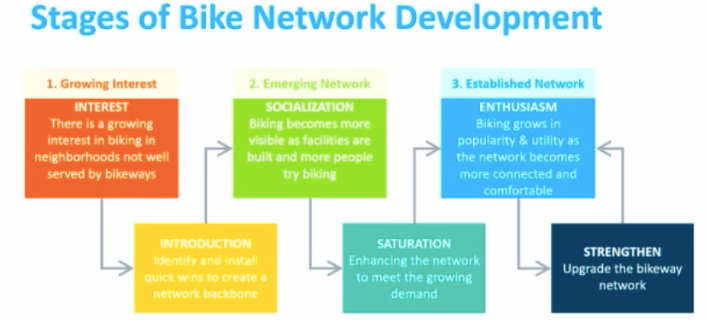
Smith said the heart of the strategy is an extensive community outreach and engagement process that begins with planning and continues after bike lanes are built. "It’s been a really effective model. Traditional models just look at streets. This starts with understanding destinations people need to connect with in their community, understanding physical and invisible barriers. Building trust and empowering people in communities to lead the process."
Smith said the strategy seems to be working: 2023 was groundbreaking year for biking in Chicago. He reported that more bicycle infrastructure was built last year than any year on record. CDOT distributed 1,500 free bicycles through their Bike Chicago program and Divvy bikes-share trips hit an all-time high: 6.6 million, a 70 percent increase over 2019. Smith said bike trips in Chicago increased a whopping 120 percent overall since 2019—the highest growth of biking anywhere in the US. (Are you listening People For Bikes, which for multiple years has ranked Chicago as one of the very worst large U.S. cities for biking?)
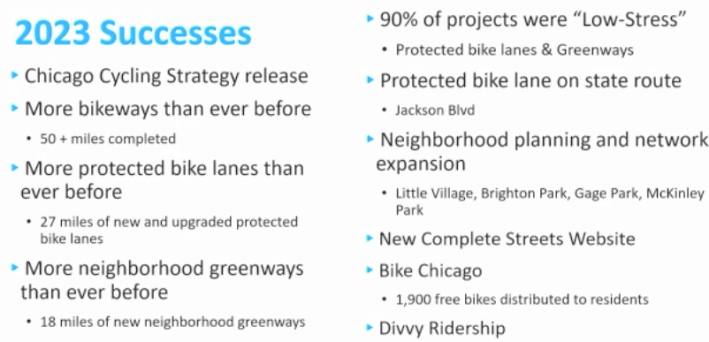
Smith emphasized the success of the neighborhood-scale projects in Belmont Cragin and North Lawndale. With input from community youth, CDOT installed 17 miles of bike lanes in Belmont Cragin in just 18 months. The department then worked its way south, extending the network into neighboring North Lawndale. In the coming year, the department intends to continue connecting adjacent neighborhoods, crossing the Chicago Sanitary and Ship Canal—a major barrier to bicyclists—and continuing into the Southwest Side neighborhoods of Little Village, Brighton Park, Gage Park and McKinley Park.
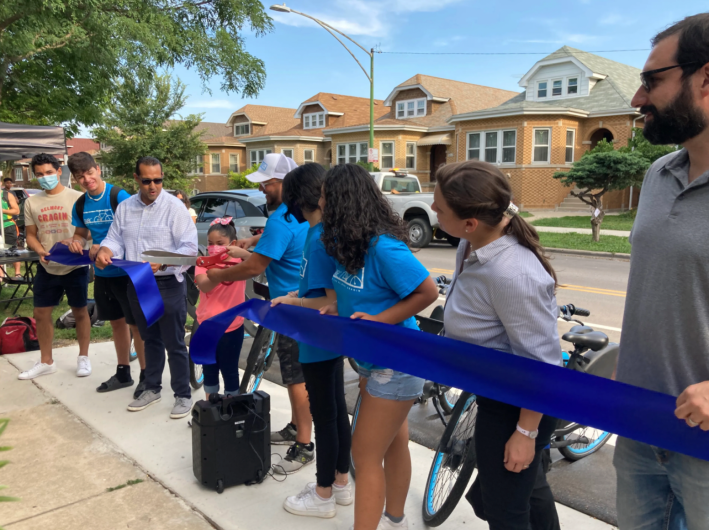
Smith concluded his presentation with some encouraging stats on the effect of PBLs and pedestrian safety improvements on car traffic. After the protected lanes on Augusta Boulevard were installed this summer, the number of drivers exceeding the 30 mph speed limit dropped by 35 percent. On Kedzie Avenue, speeding dropped 90 percent after the installation of PBLs. And on Central Park Avenue, where many visitors to Garfield Park Conservatory cross the street on foot, there has been a 60 percent reduction in speeding since the installation of PBLs. A person struck by a driver traveling 20 mph has a 90 percent chance of survival. That survival rate drops to 50 percent if the motorist is traveling 40 mph. The traffic calming effects of PBLs are a big win in a time when pedestrian deaths are at a forty year high.
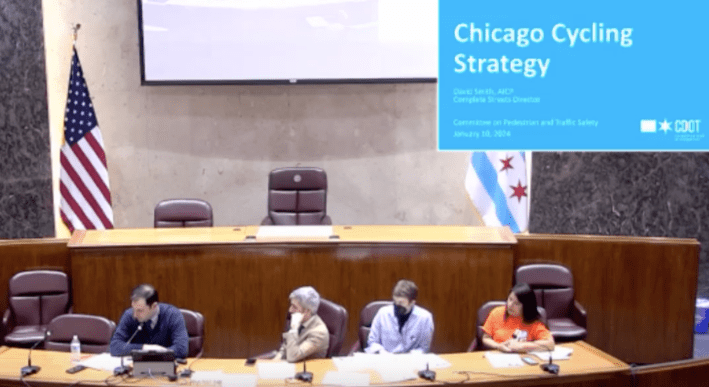
After Smith’s presentation, the floor opened to Council member Q & A. Most of the alders present were supportive of the cycling strategy. Committee chair Ald. Daniel La Spata (1st) recalled being struck by a driver while riding his bike on Belmont Avenue near the Kennedy Expressway onramp ten years ago. The alder said he had avoided biking that section of Belmont ever since—until the installation of PBLs. "Feeling like I could breathe was encouraging," he said.

Recently elected Ald. Jessie Fuentes (26th) asked Smith to talk about CDOT’s coordination with the Chicago Park District—which includes free bike riding lessons for kids and adults—and asked how dangerous intersections in her ward could be prioritized for improvements. Ald. Matt Martin (47th), like La Spata a vocal advocate for bike and pedestrian safety, asked CDOT to make a solid plan for commercial corridors, where bike lanes run the risk of being blocked by delivery trucks.
Not all Council members said were fans of new bike lanes in their wards. Ald. David Moore (17th) claimed there is little demand for bike lanes in his community, and that many residents are more concerned about fixing existing potholes than putting in bike infrastructure. He asked how much money had been spent on bike lanes since 2011 and if the funds had to be used for bike projects. Smith said he would provide figures and that funding for infrastructure comes from multiple sources at the local, state and federal levels, with varying rules and restrictions.
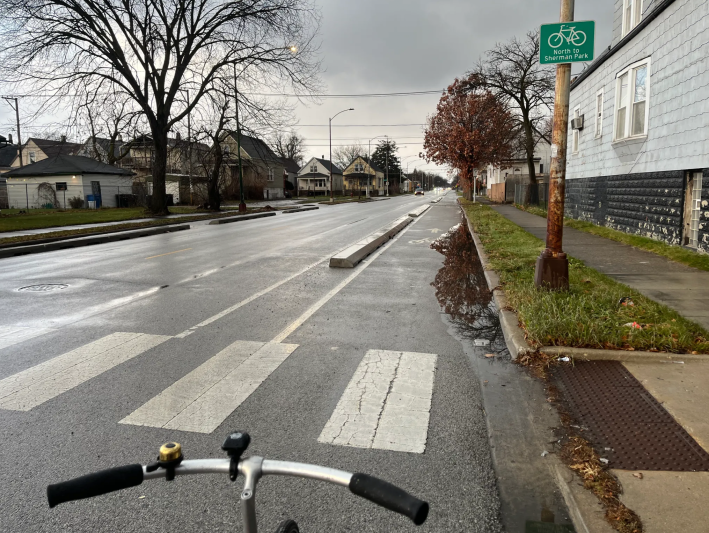
Alderman Andre Vasquez (40th) pushed back on Moore’s budgetary perspective, saying, “It’s not a zero-sum game. You can fix roads and build bike lanes." Vasquez emphasized the importance of top-down vision and praised former CDOT Commissioner Gia Biagi for her strides in bike and pedestrian safety. He asked if there have been conversations about the cycling strategy with Mayor Brandon Johnson’s office and the new administration.
Smith was unable to comment on where the Mayor’s Office stands on the plan but said CDOT would continue to "look at our Cycling Strategy as a guiding document.” Hopefully the momentum for biking and investment in bike safety continues into the new year, with support at the neighborhood, ward and city level.

Did you appreciate this post? Please consider making a tax-deductible donation.
